Kangaroos and wallabies, like many other herbivorous animals, have specific dietary preferences and nutritional needs. In the wild, these remarkable marsupials primarily rely on a plant-based diet consisting of leaves and grasses. However, when it comes to their captive care, providing them with a balanced and appropriate diet is crucial for their health and well-being.
In captivity, kangaroos and wallabies are typically fed a combination of alfalfa hay and specially formulated pellets designed for macropods. Alfalfa hay serves as a valuable source of roughage, fiber, and essential nutrients. It mimics the grasses that these animals would naturally consume in their native habitats.
The hay helps maintain proper digestion, dental health, and provides enrichment by simulating foraging behavior.
Alongside alfalfa hay, macropod pellets are an important component of their diet. These pellets are specially formulated to meet the specific nutritional requirements of kangaroos and wallabies.
They are designed to provide a balanced blend of proteins, vitamins, minerals, and other essential nutrients necessary for their growth, development, and overall health. These pellets ensure that the animals receive a complete and well-rounded diet in captivity.
It is important to note that while alfalfa hay and macropod pellets form the foundation of their diet, additional dietary enrichment is often provided. This may include introducing a variety of browse (leafy branches) from safe and suitable plants. Browse helps mimic the natural environment and provides additional texture and nutritional variety for the kangaroos and wallabies
This article delves into the dietary habits of kangaroos, uncovering their preferred foods and shedding light on their specialized feeding adaptations.
Kangaroo Species and Their Diets
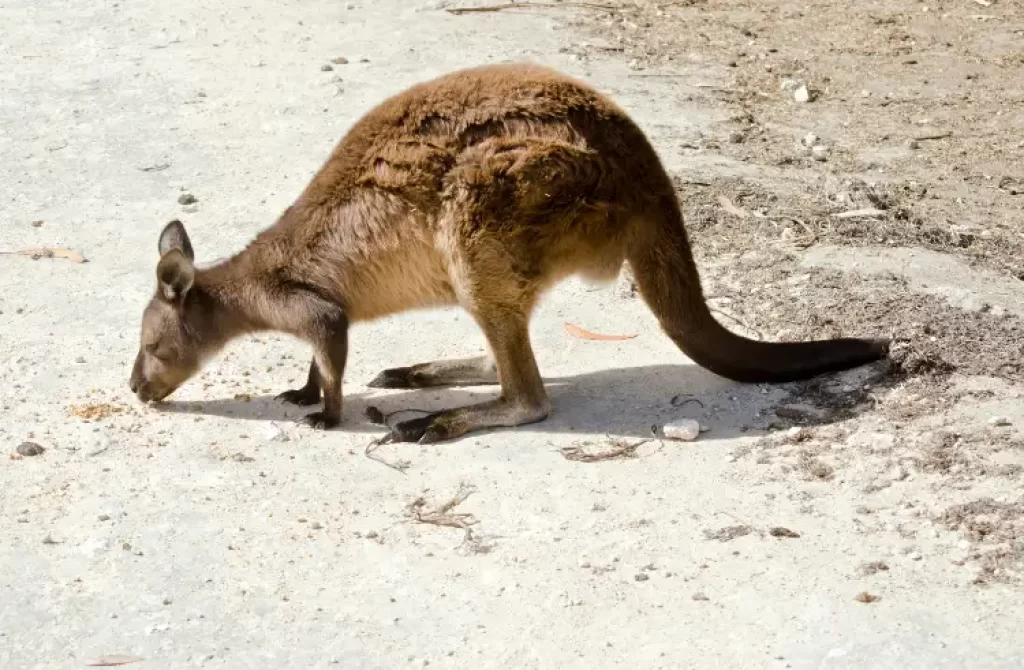
Kangaroos, a diverse group of marsupials, encompass several species with distinct dietary preferences. Understanding the dietary variations among these kangaroo species sheds light on their ecological roles and their ability to adapt to different habitats.
1.1 Red Kangaroo (Macropus rufus)
The largest kangaroo species, the red kangaroo, primarily feeds on grasses. They have evolved to thrive in arid and semi-arid regions, where they can efficiently extract moisture from the vegetation they consume. Their diet consists of various grass species, such as Mitchell grass and kangaroo grass.
1.2 Eastern Grey Kangaroo (Macropus giganteus)
Eastern grey kangaroos are predominantly grazers and feed on a wide range of grasses and herbs. They can adapt to different habitats, from open grasslands to woodland areas. These kangaroos are known to prefer the tender, young shoots of grasses, which provide optimal nutrition.
1.3 Western Grey Kangaroo (Macropus fuliginosus)
Western grey kangaroos are browsers that consume a variety of shrubs, herbs, and low-lying vegetation. They have a more flexible diet compared to other kangaroo species and can feed on a diverse range of plant species, including leafy greens, fruits, and even tree bark.
1.4 Agile Wallaby (Macropus agilis)
Agile wallabies have a mixed diet, incorporating grasses, herbs, and browse. They are well adapted to consume various plant species found in their coastal and tropical habitats. Their diet includes grasses, sedges, young shoots, and the leaves and fruits of shrubs.
1.5 Rock Wallaby (Petrogale spp.)
Rock wallabies exhibit dietary adaptations to rocky habitats. They consume a combination of grasses, herbs, and browse, including leaves, fruits, and bark. Some rock wallaby species, such as the black-flanked rock wallaby, have been observed to eat a substantial amount of leaves from shrubs and trees.
1.6 Tree Kangaroo (Dendrolagus spp.)
Tree kangaroos, as their name suggests, have adapted to arboreal environments. They primarily feed on leaves, fruits, flowers, and bark found in the canopy of rainforests. Their diet includes a variety of tree species, such as figs, leaves, and epiphytes.
The dietary preferences of kangaroo species are influenced by factors such as habitat availability, seasonal variations, and regional ecological conditions. These variations in diet contribute to the diverse roles kangaroos play within their respective ecosystems, as they influence plant communities, seed dispersal, and nutrient cycling.
Herbivorous Lifestyle
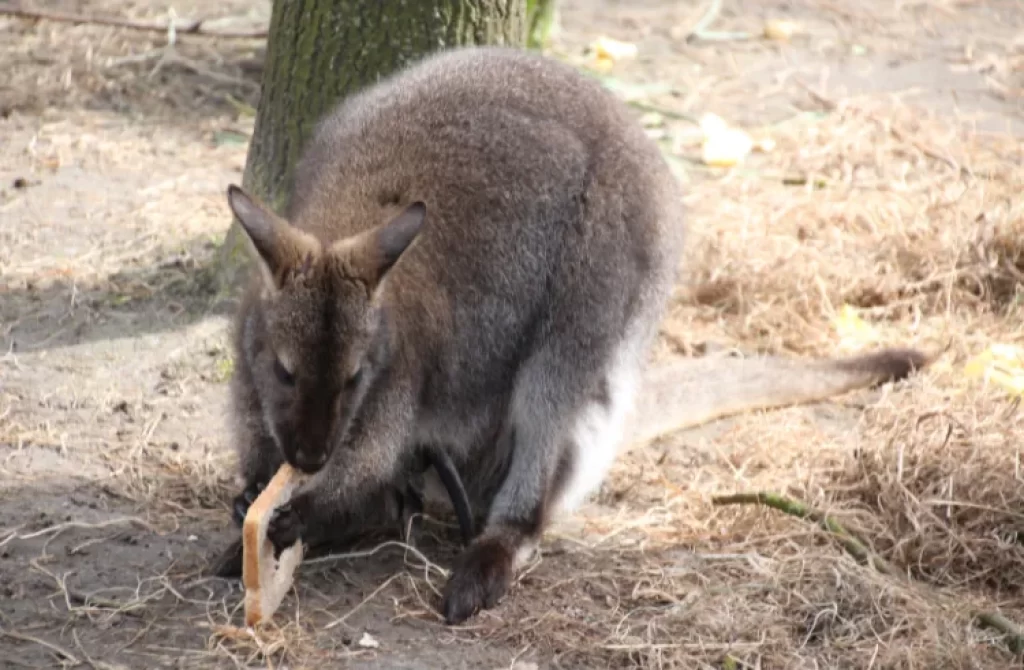
Kangaroos, being herbivores, have evolved unique adaptations to thrive on a plant-based diet. Their herbivorous lifestyle is shaped by specialized digestive systems and interactions with their environment. Understanding these adaptations provides insight into how kangaroos efficiently extract nutrients from plant material.
1.1 Digestive System Adaptations
Kangaroos possess a specialized digestive system that enables them to extract maximum nutrition from the plant material they consume. Their digestive tract consists of a four-chambered stomach, similar to ruminants. This complex digestive system allows kangaroos to efficiently break down fibrous plant matter.
1.2 High-Fiber Diet
Kangaroos have a high-fiber diet, primarily composed of grasses, herbs, leaves, and other plant material. Fiber-rich foods provide essential carbohydrates and facilitate proper gut function. Grasses, in particular, form a significant part of their diet, supplying the necessary nutrients for their energy requirements.
1.3 Gut Microbes
The digestive success of kangaroos relies on a symbiotic relationship with specialized gut microbes. These microbes, including bacteria and protozoa, reside in the kangaroo’s foregut chambers, aiding in the breakdown of cellulose and other complex carbohydrates. They ferment plant material and produce volatile fatty acids, which serve as an energy source for kangaroos.
1.4 Selective Feeding
Kangaroos exhibit selective feeding behavior, preferring certain plant species and parts over others. They have the ability to differentiate between various grasses and plants, choosing those with higher nutritional value. This selectivity allows them to optimize their diet and meet their specific dietary requirements.
1.5 Coping with Limited Water Availability
Kangaroos inhabit diverse habitats, including arid and semi-arid regions where water availability is limited. To cope with these conditions, kangaroos have developed physiological adaptations that allow them to extract moisture from the vegetation they consume. This enables them to survive in environments where water sources are scarce.
1.6 Seasonal Diet Variation
Kangaroos also exhibit seasonal diet variations, adapting to changes in food availability throughout the year. During periods of abundant rainfall and vegetation growth, they may have access to a wider range of plant species. In contrast, during drier seasons, their diet may consist of more drought-tolerant plants and grasses.
Understanding the herbivorous lifestyle of kangaroos provides valuable insights into their ecological roles and their impact on plant communities. By consuming plant material and dispersing seeds, kangaroos contribute to plant regeneration and the maintenance of ecosystem balance.
Preferred Foods
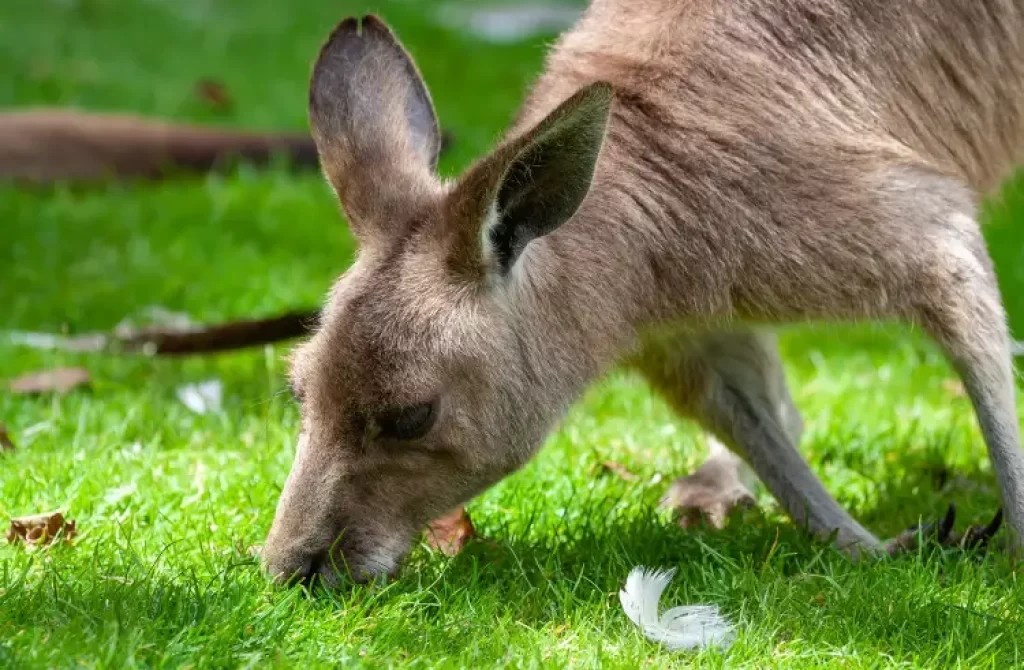
Kangaroos have distinct preferences when it comes to their food selection, showcasing a specialized diet adapted to their unique ecological niche. Understanding the preferred foods of kangaroos sheds light on their dietary requirements and their role in shaping ecosystems.
Grasses
Grasses form a significant part of the kangaroo’s diet. Kangaroos are well-adapted to grazing on various grass species, including native grasses such as kangaroo grass (Themeda triandra) and wallaby grass (Austrodanthonia spp.). They possess specialized teeth and jaws for efficiently grazing on grasses, extracting maximum nutrition from these fibrous plants.
Herbs and Forbs
Kangaroos also consume a variety of herbs and forbs. These include low-growing flowering plants and non-woody vegetation. Examples of herbs and forbs commonly consumed by kangaroos include daisies, clovers, and plantain. These plant species provide additional nutrients and diversity to the kangaroo’s diet.
Leafy Vegetation
Leafy vegetation, such as the leaves of shrubs and small trees, is another preferred food source for kangaroos. They browse on a range of leafy plants, including eucalyptus, acacias, and melaleucas. Leafy vegetation contributes to their nutritional requirements, supplying essential vitamins and minerals.
Seasonal Variations
Kangaroo diets can vary throughout the year, influenced by seasonal changes in food availability. During periods of abundant rainfall and vegetation growth, kangaroos have access to a wider range of food resources. They may consume a greater variety of grasses, herbs, and leafy vegetation. In contrast, during drier seasons, they may rely more on drought-tolerant plants and grasses.
Adaptation to Food Availability
Kangaroos have evolved to adapt to the availability of different food resources. They can adjust their feeding habits and dietary preferences based on environmental conditions. This adaptability allows them to thrive in diverse habitats, ranging from open grasslands to woodland areas, where different plant species dominate.
Seed Dispersal
Kangaroos play a crucial role in seed dispersal. As they graze on various grasses and browse on plants, they inadvertently consume and disperse seeds in their droppings. This process contributes to the regeneration and dispersal of plant species, enhancing plant diversity and ecosystem resilience.
Understanding the preferred foods of kangaroos provides valuable insights into their ecological interactions and the impact of their feeding habits on plant communities. By selectively feeding on specific plant species, kangaroos contribute to the maintenance of plant diversity and ecosystem functioning.
Feeding Behavior and Foraging Strategies
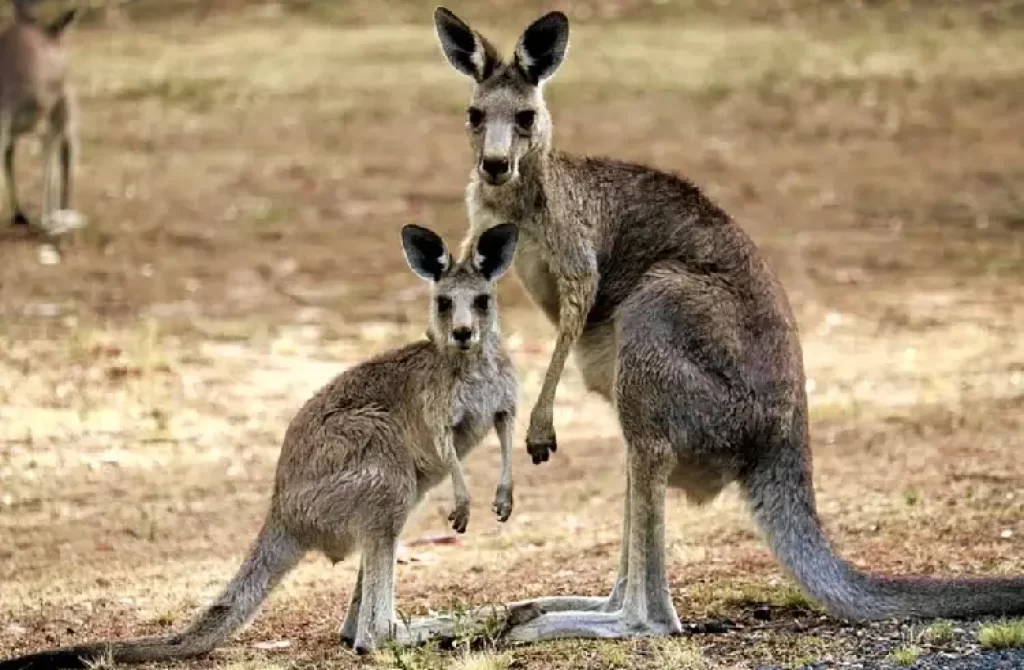
To survive in their unique environments, kangaroos have developed specific feeding behaviors and foraging strategies. This section explores the grazing and browsing habits of kangaroos, their preference for open grasslands or woodlands, and their ability to conserve water by obtaining moisture from their food.
Human Interaction and Feeding Kangaroos
With increasing human interaction, there is a growing interest in feeding kangaroos. This section explores the implications of human feeding practices on kangaroo health, behavior, and their natural foraging patterns. It provides guidelines for responsible kangaroo feeding, emphasizing the importance of respecting their dietary needs and avoiding detrimental effects.
Kangaroo Diet Facts and Eating Habits: How Much Do They Eat?
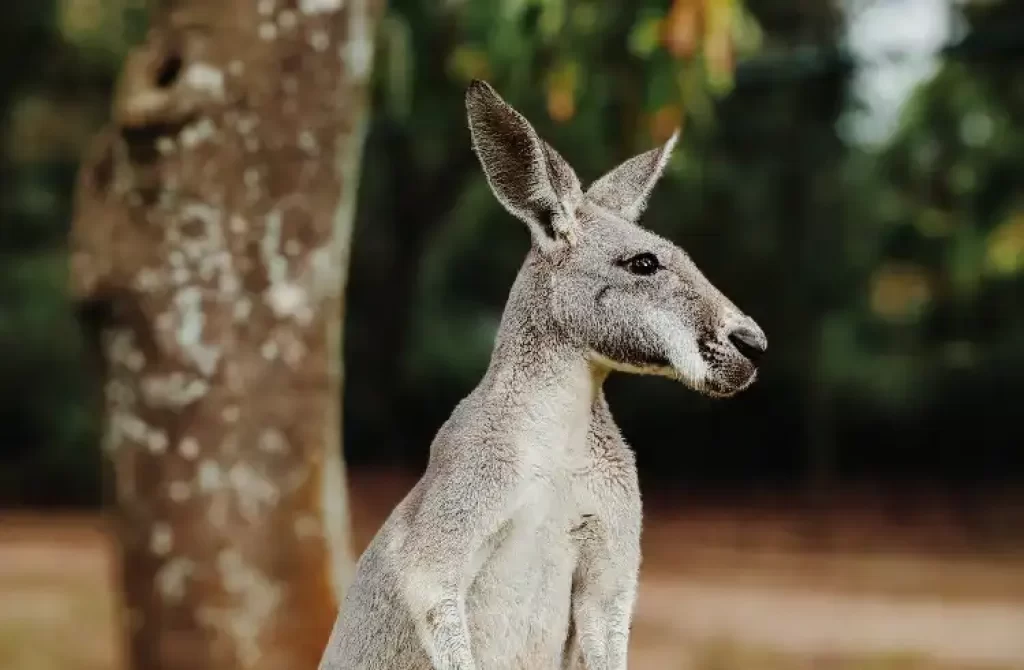
Herbivores by nature, kangaroos consume a large amount of vegetation daily. Their diet consists primarily of grasses, leaves, flowers, and fruits. However, the amount of food a kangaroo eats varies depending on the species, age, and gender.
Kangaroos have a unique digestive system that allows them to extract more nutrients from their food than other herbivores. This means they don’t need to eat as much as other animals to maintain their energy levels. During periods of drought or food scarcity, kangaroos can survive by reducing their food intake and relying on their fat reserves.
Adult male kangaroos can eat up to 1.5 kg of vegetation per day while females consume around 1 kg. However, younger animals require less food than adults due to their smaller size and lower activity levels.
Kangaroos are known for grazing during the early morning and late afternoon hours when temperatures are cooler. They also rest during the hottest parts of the day to conserve energy. Kangaroos typically feed on a variety of plants in order to obtain all the necessary nutrients for survival.
In addition to grasses and leaves, kangaroos also consume bark from trees in times of drought or when other sources of food are scarce. This helps them stay hydrated since tree bark contains water.
Interestingly enough, some species of kangaroo have been known to eat soil as well. This is thought to provide additional minerals that may be lacking in their diet.
Where Do Kangaroos Find Their Food? Exploring Their Habitat and Environment
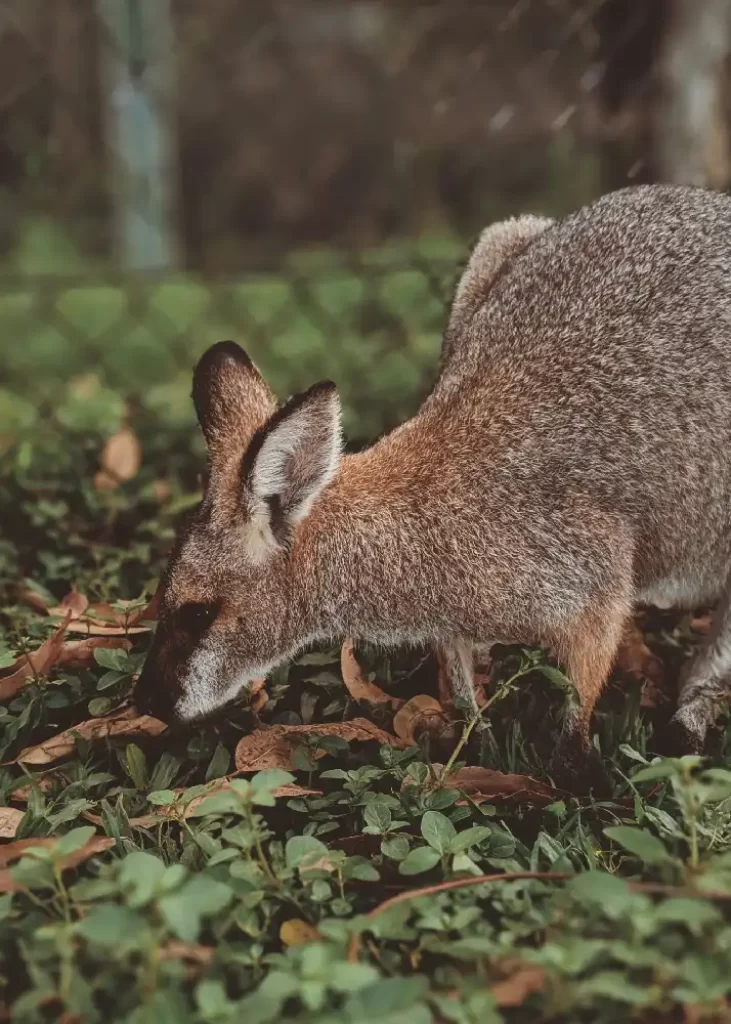
Terrestrial kangaroos find their food on the ground, while tree kangaroos look for food in trees. These marsupials have adapted to different environments and have evolved to eat what is available in their habitats. For example, tree kangaroos are found in tropical rainforests where they feed on leaves, fruit, and flowers of trees. They use their long tails for balance as they climb up and down trees to find food. In contrast, terrestrial kangaroos such as red and grey kangaroos live in open habitats like grasslands or savannas where they graze on grasses and shrubs.
Baby kangaroos rely on their mother’s milk for the first few months of their life before transitioning to solid food. Female kangaroos have a special pouch called a marsupium where they carry their young until they are old enough to leave the pouch and forage for themselves. Kangaroo milk is highly nutritious and contains antibodies that help protect the young joeys from infections.
Ordinary kangaroos like red and grey kangaroos graze on grasses and shrubs in open habitats. They have specialized teeth that allow them to grind tough vegetation. Kangaroos can go without water for long periods by using metabolic water produced during digestion.
Larger kangaroo species such as antilopine and red kangaroo require more food and water than smaller species like wallabies because of their size. Antilopine kangaroo has a diet consisting mainly of grasses while red kangaroo feeds on both grasses and shrubs.
In captivity, zookeepers provide a varied diet for captive kangaroos that includes hay, fruits, vegetables, and pellets to ensure they receive all necessary nutrients. This diet mimics what wild kangaroos would eat in the wild but with additional supplements if needed.
The Importance of Water in a Kangaroo’s Diet: How Do They Stay Hydrated?
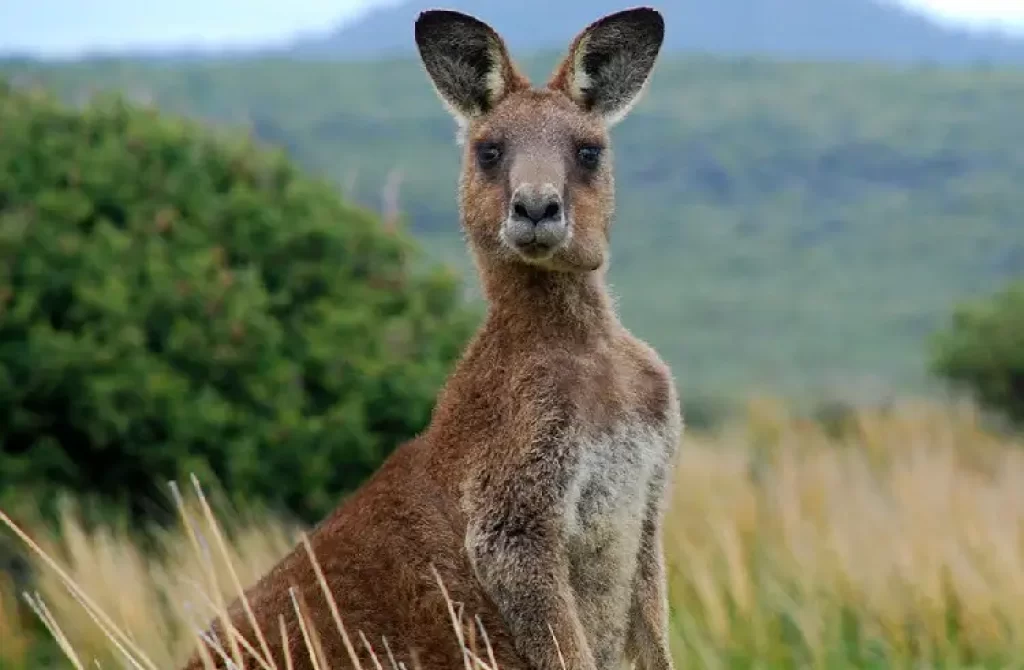
Kangaroos are fascinating creatures that have adapted to the harsh Australian environment. As a herbivorous animal, their diet consists of various plants and grasses. However, one crucial aspect of their diet is often overlooked – water. In this section, we will discuss the importance of water in a kangaroo’s diet and how they stay hydrated.
Obtaining Water from Plants
Kangaroos can obtain some of their water needs from the plants they eat. They have evolved to consume plants with high moisture content and low fiber content, such as succulent leaves and fruits. During droughts when water is scarce, kangaroos will switch to eating more fibrous plants that contain less moisture but are still essential for survival.
Drinking Water Regularly
Despite being able to obtain some water from their food, kangaroos also need to drink water regularly. They are known to travel long distances in search of watering holes or rivers where they can quench their thirst. Kangaroo mothers also produce milk that is high in water content, which helps keep their young hydrated.
Efficient Digestive System
Kangaroos have a highly efficient digestive system that allows them to extract as much water as possible from their food. Their stomach has four compartments – rumen, reticulum, omasum, and abomasum – which work together to break down tough plant material and extract nutrients and moisture efficiently.
Cooling Down
During hot weather, kangaroos will lick their forearms to cool down and reduce their need for water. The saliva on their skin evaporates quickly, creating a cooling effect that helps regulate body temperature.
Finding Water During Droughts
Finding water during droughts can be challenging for kangaroos. They may travel long distances in search of reliable sources of freshwater or rely on underground springs or wells if available. Some species of kangaroos are known to dig into dry creek beds to access water that may be trapped beneath the surface.
Teaching Kids About Kangaroo Diets: Fun and Educational Activities
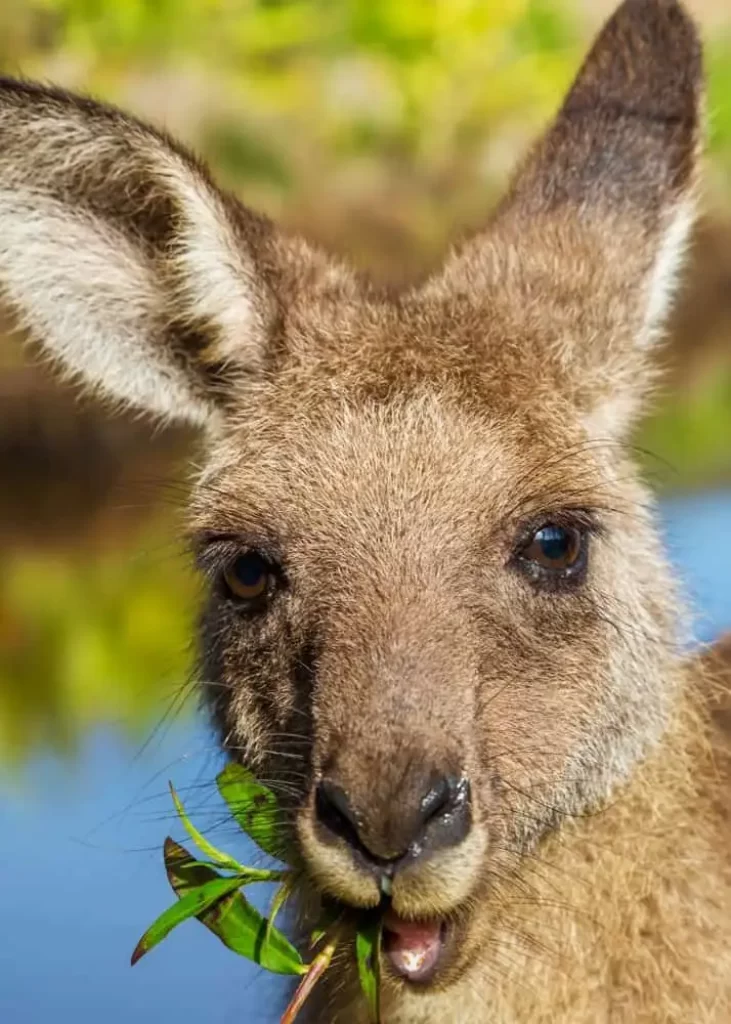
Fun Activities for Teaching Kids About Kangaroo Diets
Teaching kids about the diets of different animals can be a fun and educational experience. there are many exciting activities that you can use to help children understand what these creatures eat and how they survive in the wild.
One of the best ways to teach kids about kangaroo diets is through interactive games. For example, you could create a matching game where kids match pictures of different foods with the types of kangaroos that eat them. This will help children learn about the variety of foods that kangaroos consume, from grasses to leaves and even insects.
Another fun activity is creating a food chain or web using pictures or drawings of various Australian animals, including kangaroos. This will help kids understand how different animals rely on each other for survival and how their diets are interconnected.
Baby Kangaroos’ Diet and How It Changes Over Time
Baby kangaroos, also known as joeys, have very specific dietary needs. When first born, joeys rely solely on their mother’s milk for nourishment. As they grow older, they begin to explore solid foods such as grasses and leaves.
As joeys continue to age, their diet changes again. They start eating more solid food while still nursing from their mothers until they are fully weaned at around eight months old.
It’s interesting to note that baby kangaroos learn about food choices from their mothers. Mother kangaroos teach their young which plants are safe to eat by licking them before offering them to their joeys.
The Role of Mother Kangaroo in Teaching Her Baby About Food
Mother kangaroos play an essential role in teaching their babies about food choices and survival skills. In addition to teaching her baby which plants are safe to eat, she also teaches her joey how to find water sources and avoid predators.
Kangaroo mothers carry their joeys in their pouches for several months after birth, providing them with warmth and protection from the elements. During this time, joeys learn by observing their mothers’ behaviors and movements.
As joeys grow older, they become more independent but still rely on their mothers for guidance. Mother kangaroos continue to teach their young about food choices and survival skills until they are fully weaned and ready to fend for themselves.
Kangaroos’ Feeding Habits During the Day and Night
Kangaroos are primarily herbivores, meaning they eat plants. They have a unique digestive system that allows them to extract as much nutrition as possible from tough plant materials such as grasses.
Most kangaroos feed during the night or early morning hours when temperatures are cooler. This helps them conserve energy during hot days when temperatures can reach over 100 degrees Fahrenheit in some parts of Australia.
During feeding times, kangaroos use their powerful hind legs to move around quickly while grazing on grasses or browsing on leaves. They also use their long tails for balance and support while standing upright.
Understanding Kangaroo Diets and Their Place in the Animal Kingdom
Kangaroos are fascinating creatures that have adapted to their unique environment in Australia. They have a specialized diet that allows them to survive in harsh conditions, and their place in the animal kingdom is crucial for maintaining balance and biodiversity.
These marsupials primarily feed on plants such as grasses, leaves, and bark. However, they are also known to consume meat, including insects, small rodents, and birds. This diverse diet ensures that kangaroos can obtain the necessary nutrients needed for survival.
Kangaroos have an interesting eating habit where they regurgitate their food to chew it again before swallowing. This process helps break down tough plant materials and aids in digestion. They also have a slow metabolic rate that allows them to conserve energy during periods of food scarcity.
The habitat of kangaroos plays a significant role in their diet. These animals are found mostly in open grasslands and savannas where vegetation is abundant. They rely heavily on water sources such as rivers, lakes, and streams for hydration.
Compared to wallabies, kangaroos generally consume more fibrous plants due to their larger size. Wallabies tend to eat more leafy greens and fruits rather than grasses.
Teaching kids about kangaroo diets can be both fun and educational. Activities such as creating a food chain or playing games that simulate the digestive process can help children understand how these animals survive in the wild.
Interesting facts about kangaroo diets include their ability to go without water for extended periods by obtaining moisture from their food. Female kangaroos produce two types of milk simultaneously – one for newborn joeys and another for older offspring still nursing.
The role of kangaroo diets within their ecosystem cannot be underestimated. As herbivores, they play a critical role in maintaining vegetation growth by controlling plant populations through grazing activities. They also serve as prey for larger predators, helping to maintain balance within the food chain.







